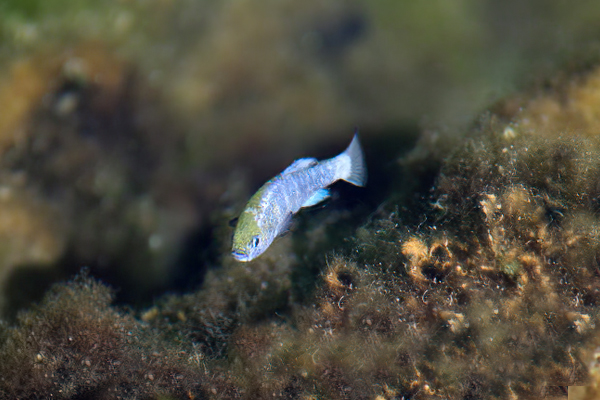Threatened & Endangered Species

Amargosa Pupfish - USFWS photo
Ash Meadows National Wildlife Refuge supports 25 plants and animals which are found nowhere
else in the world. Of these unique "endemic species," five are currently listed as endangered
and seven as threatened. The four endangered fish species found on the refuge are Devil's Hole
pupfish, Ash Meadows Amargosa pupfish, Warm Springs pupfish, and Ash Meadows speckled dace.
One endangered plant occurring on the refuge is the Amargosa niterwort. Six species of plants
are currently listed as threatened: Ash Meadows milk-vetch,, spring-loving centaury plant,
Ash Meadows sunray, Ash Meadows ivesia, Ash Meadows gumplant, and Ash Meadows blazing star.
The Ash Meadows naucorid, an aquatic beetle, is also listed as threatened.
Ash Meadows has a greater concentration of endemic life than any other area in the
United States and the second greatest in North America. Twenty-five endemic species have
adapted to live in and around the waters of Ash Meadows.
Approximately 10,000 years ago, large lakes and rivers were common in Nevada. As the climate
warmed, these waters began to dry up, recede, and separate. This left behind isolated species
within and around small bodies of water.
Of these endemic species, five are endangered and seven threatened with extinction. This is
due to habitat destruction and competition with non-native species.
The purpose of the Endangered Species Act is to protect threatened and endangered species
and to conserve them in the wild. Ash Meadows has the most threatened and endangered species
of any National Wildlife Refuge.
Endangered means there is still time. When a species becomes endangered, it indicates something
is wrong with the ecosystem. The measures we take to save endangered species help ensure
the world we leave for our children is as healthy as the world our parents left for us.
Devil's Hole pupfish occur naturally only within Devil's Hole. This small, water-filled cavern
is adminstered as a disjunct portion of Death Valley National Park. Two additional populations
of Devil's Hole pupfish are managed within "refugia" on the refuge. For public safety, and to
protect the fish, security fences are maintained around Devil's Hole and the refugia.
Ash Meadows Amargosa pupfish can be seen within most of the larger springs and streams on the
refuge, and are especially visible and colorful at the Point of Rocks springs. Populations
of this pupfish have recovered very well since the refuge was established in 1984 and are
currently proposed for removal from the endangered species list.
The Crystal Spring Interpretive Boardwalk is a good location to view threatened plants such
as spring-loving centaury, Ash Meadows gumplant and ivesia, as well as many other unique
plants which require moist soils occuring in the proximity to this spring and stream. The
boardwalk was designed to allow visitors access to this unique and fragile habitat, while
protecting it.
In addition to all of the endemic species, a few pairs of endangered Southwestern willow
flycatchers use Ash Meadows as breeding habitat from June through August each year. Two
endangered species success stories, the peregrine falcon and bald eagle also use Ash Meadows
seasonally as a migration stop over.
Refuge Habitat Wildlife Wildlife Calendar Threatened & Endangered Species Plants History Restoration Quick Refuge Facts